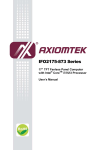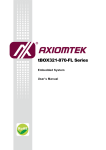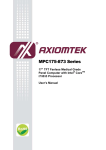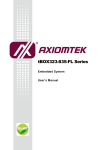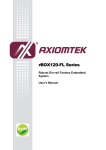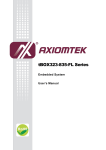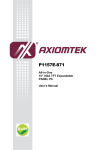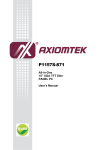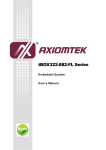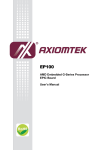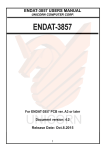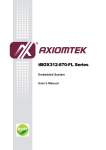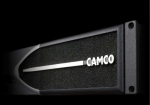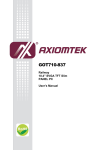Download eBOX730-860-FL A1 User Manual
Transcript
eBOX660-872-FL Series Embedded System User’s Manual Disclaimers This manual has been carefully checked and believed to contain accurate information. Axiomtek Co., Ltd. assumes no responsibility for any infringements of patents or any third party’s rights, and any liability arising from such use. Axiomtek does not warrant or assume any legal liability or responsibility for the accuracy, completeness or usefulness of any information in this document. Axiomtek does not make any commitment to update the information in this manual. Axiomtek reserves the right to change or revise this document and/or product at any time without notice No part of this document may be reproduced, stored in a retrieval system, or transmitted, in any form or by any means, electronic, mechanical, photocopying, recording, or otherwise, without the prior written permission of Axiomtek Co., Ltd. Copyright 2013 Axiomtek Co., Ltd. All Rights Reserved July 2013, Version A1 Printed in Taiwan ii Safety Precautions Before getting started, please read the following important safety precautions. 1. The eBOX660-872-FL does not come equipped with an operating system. An operating system must be loaded first before installing any software into the computer. 2. Be sure to ground yourself to prevent static charge when installing the internal components. Use a grounding wrist strap and place all electronic components in any static-shielded devices. Most electronic components are sensitive to static electrical charge. 3. Disconnect the power cord from the eBOX660-872-FL before making any installation. Be sure both the system and the external devices are turned OFF. Sudden surge of power could ruin sensitive components. Make sure the eBOX660-872-FL is properly grounded. 4. Make sure the voltage of the power source is correct before connecting the equipment to the power outlet. 5. Turn OFF the system power before cleaning. Clean the system using a cloth only. Do not spray any liquid cleaner directly onto the screen. 6. Do not leave this equipment in an uncontrolled environment where the storage temperature is below -20℃ or above 80℃. It may damage the equipment. 7. Do not open the system’s back cover. If opening the cover for maintenance is a must, only a trained technician is allowed to do so. Integrated circuits on computer boards are sensitive to static electricity. To avoid damaging chips from electrostatic discharge, observe the following precautions: Before handling a board or integrated circuit, touch an unpainted portion of the system unit chassis for a few seconds. This will help to discharge any static electricity on your body. When handling boards and components, wear a wrist-grounding strap, available from most electronic component stores. iii Classification 1. 2. 3. 4. iv Degree of production against electric shock : not classified Degree of protection against the ingress of water : IP40 Equipment not suitable for use in the presence of a flammable anesthetic mixture with air or with oxygen or nitrous oxide. Mode of operation : Continuous General Cleaning Tips You may need the following precautions before you begin to clean the computer. When you clean any single part or component for the computer, please read and understand the details below fully. When you need to clean the device, please rub it with a piece of dry cloth. 1. Be cautious of the tiny removable components when you use a vacuum cleaner to absorb the dirt on the floor. 2. Turn the system off before you start to clean up the component or computer. 3. Never drop the components inside the computer or get circuit board damp or wet. 4. Be cautious of all kinds of cleaning solvents or chemicals when you use it for the sake of cleaning. Some individuals may be allergic to the ingredients. 5. Try not to put any food, drink or cigarette around the computer. Cleaning Tools: Although many companies have created products to help improve the process of cleaning your computer and peripherals users can also use household items to clean their computers and peripherals. Below is a listing of items you may need or want to use while cleaning your computer or computer peripherals. Keep in mind that some components in your computer may only be able to be cleaned using a product designed for cleaning that component, if this is the case it will be mentioned in the cleaning. Cloth: A piece of cloth is the best tool to use when rubbing up a component. Although paper towels or tissues can be used on most hardware as well, we still recommend you to rub it with a piece of cloth. Water or rubbing alcohol: You may moisten a piece of cloth a bit with some water or rubbing alcohol and rub it on the computer. Unknown solvents may be harmful to the plastics parts. Vacuum cleaner: Absorb the dust, dirt, hair, cigarette particles, and other particles out of a computer can be one of the best methods of cleaning a computer. Over time these items can restrict the airflow in a computer and cause circuitry to corrode. Cotton swabs: Cotton swaps moistened with rubbing alcohol or water are excellent tools for wiping hard to reach areas in your keyboard, mouse, and other locations. Foam swabs: Whenever possible it is better to use lint free swabs such as foam swabs. NOTE: We strongly recommended that you should shut down the system before you start to clean any single components. Please follow the steps below: 1. 2. 3. 4. 5. Close all application programs Close operating software Turn off power switch Remove all device Pull out power cable v Scrap Computer Recycling If the computer equipment’s need the maintenance or are beyond repair, we strongly recommended that you should inform your Axiomtek distributor as soon as possible for the suitable solution. For the computers that are no longer useful or no longer working well, please contact your Axiomtek distributor for recycling and we will make the proper arrangement. Trademarks Acknowledgments Axiomtek is a trademark of Axiomtek Co., Ltd. IBM, PC/AT, PS/2, VGA are trademarks of International Business Machines Corporation. Intel® , Core™ and Pentium® are registered trademarks of Intel Corporation. MS-DOS and Microsoft® are trademarks of Microsoft Corporation. W indows 7, W indows8, W indows 7 Embedded, W indows 8 Embedded, Linux, MSDOS, Microsoft® and other brand names and trademarks are the properties and registered brands of their respective owners. vi Table of Contents Disclaimers .............................................................................................................. ii Safety Precautions ................................................................................................. iii Classification .......................................................................................................... iv General Cleaning Tips ............................................................................................ v Scrap Computer Recycling.................................................................................... vi CHAPTER 1 INTRODUCTION ........................................................................ 1 1.1 1.2 1.2.1 1.2.2 1.2.3 1.2.4 1.3 1.3.1 1.3.2 1.4 1.5 1.6 General Description ............................................................................ 1 System Specifications ........................................................................ 2 CPU .................................................................................................................... 2 I/O System ......................................................................................................... 2 System Specification ........................................................................................ 2 Driver CD Content ............................................................................................. 3 Dimensions ......................................................................................... 4 System Dimension ............................................................................................ 4 Wall mount Bracket Dimension ....................................................................... 5 I/O Outlets ........................................................................................... 6 Packing List ......................................................................................... 8 Model List ............................................................................................ 8 CHAPTER 2 HARDWARE INSTALLATION .................................................... 9 2.1 2.2 2.3 2.4 Installing the 2.5” SATA Device ......................................................... 9 Installing the Memory Module .......................................................... 12 Installing the CFast™ ....................................................................... 18 Installing the Express Mini Card ...................................................... 19 CHAPTER 3 Jumper Setting & Connectors ............................................... 21 3.1 3.2 3.2.1 3.2.2 3.2.3 3.2.4 3.2.5 3.2.6 3.2.7 3.2.8 3.2.9 3.2.10 3.2.11 3.2.12 3.2.13 3.2.14 3.2.15 3.3.16 3.2.17 SBC Placement ................................................................................. 21 Jumper Settings and Connectors .................................................... 23 CMOS Clear Jumper (SJP2 on SBC87872) ................................................... 24 MiniCard / mSATA Setting (JP1 on AX93707) .............................................. 24 Wide Range DC Power In Connector ............................................................ 24 Isolated Digital Input Connector ................................................................... 25 Isolated Digital Output Connector ................................................................ 26 VGA Connector ............................................................................................... 27 DisplayPort Connector ................................................................................... 27 USB 3.0 Connector ......................................................................................... 28 COM1~COM4 Serial Port Connector ............................................................. 28 Audio Connector ............................................................................................. 29 Ethernet Connector (LAN1~LAN4) ................................................................ 29 ATX Power On/OFF Button ............................................................................ 29 Reset Button.................................................................................................... 30 SATA & SATA Power Connector ................................................................... 30 CFast™ Socket ................................................................................................ 31 SIM Card Slots................................................................................................. 31 Express Mini Card Slot ................................................................................... 32 vii CHAPTER 4 AMI BIOS SETUP UTILITY ...................................................... 33 4.1 4.2 4.3 4.4 4.5 4.6 4.7 4.8 Starting .............................................................................................. 33 Navigation Keys ................................................................................ 33 Main Menu ......................................................................................... 35 Advanced Menu................................................................................. 36 Chipset Menu .................................................................................... 47 Boot Menu ......................................................................................... 52 Security Menu ................................................................................... 53 Save & Exit Menu .............................................................................. 54 Appendix Watchdog Timer.......................................................................... 57 About Watchdog Timer .................................................................................... 57 Assembler Sample Program ............................................................................ 58 viii eBOX660-872-FL Series User’s Manual CHAPTER 1 INTRODUCTION This chapter contains general information and detailed specifications of the eBOX660-872-FL. The Chapter 1 includes the following sections: 1.1 General Description System Specification Dimensions I/O Outlets Packing List General Description The eBOX660-872-FL is an embedded system that supports Socket G2 Intel® Core™ i7/i5/i3/Celeron processor to support W indows 7, W indows 7 Embedded, W indows 8, W indows 8 Embedded or Linux, suitable for the most endurable operation. It features fan less design with full feature I/O, two 204-pin unbuffered SODIMM socket for dual channel DDR3-1066/1333 MHz memory, and enhanced system dependability by built-in W atchdog Timer. Features ® Intel Ivy Bridge HM76 Platform Support Socket G2 Intel® Core™ i7/i5/i3/Celeron processor Maximum to 16GB DDR3 1066/1333 MHz memory Compact and fanless design Supports 4 USB 3.0 ports Supports 4 jump-less RS-232/422/485 Supports 4 10/100/1000Mbps Ethernet ports One DisplayPort One VGA One 2.5” SATA HDD drive bay One front access CFast Watchdog timer Wide Range 10-30VDC input Dual Express Mini Card slot with SIM slots Antenna openings Reliable and Stable Design The eBOX660-872-FL adopts the advanced cooling system and supporting the CFast™, which makes it especially suitable for vibration environments, best for industrial automation, digital signage and gaming application. Embedded O.S. Supported The eBOX660-872-FL not only supports Windows 7, Windows 8, but also supports embedded OS, such as Windows 7 Embedded, Windows 8 Embedded and Linux . Introduction 1 eBOX660-872-FL Series User’s Manual Various Storage devices supported For storage device, the eBOX660-872-FL supports one 2.5" SATA storage drive bay, and one CFast™ slot. 1.2 System Specifications 1.2.1 CPU CPU Socket G2 Intel® Core™ i7/i5/i3/Celeron processor W orking temperature depends on TDP of processor, please refer to 1.2.3 System Specification Chipset Intel® Ivy Bridge chipset BIOS American Megatrends Inc. UEFI (Unified Extensible Firmware Interface) BIOS. System Memory Two 204-pin unbuffered DDR3 1066/1333MHz SO-DIMM socket.max. up to 16GB 1.2.2 I/O System Four jumper-less RS-232/422/485. COM1~COM4 for full function 9-pin D-Sub male connectors One VGA connector for display Dual DisplayPort for display Two Audio connectors (Mic-IN, Line-OUT) Four RJ-45 connectors for 10/100/1000Base-T Ethernet ports Four USB 3.0 connectors Four Digital Input and four Digital Output for digital I/O phoenix connector One 10-30V wide range DC input connector Six Indicators (System Power, HDD Active, LAN1 link, LAN2 link, LAN3 link, LAN4 link) One Reset switch One AT/ATX switch One Power switch 1.2.3 System Specification Watchdog Timer 1~255 seconds or minutes; up to 255 levels. Power Supply 10-30V wide range DC input connector Operation Temperature -20℃ ~ 70℃ (-4 ºF ~ 158ºF), with TDP 35W Storage Temperature 2 -20℃ ~ 60℃ (-4 ºF ~ 140ºF), with TDP 45W -40℃ ~ 80℃ (-4 ºF ~ 176ºF) Introduction eBOX660-872-FL Series User’s Manual Humidity Vibration Endurance 10% ~ 90% (non-condensation) 1Grm w/ CFast and SSD (5-500Hz, X, Y, Z directions) Weight 3.8 kg (8.37 lb) without package kg(10.14 lb) with package Dimensions 280mm(11.02”) (W) x190mm(7.48”) (D) x 76mm(2.99”) (H) 1.2.4 Driver CD Content Driver Audio Chipset Ethernet Graphic Manual User Manual Quick Manual NOTE: All specifications and images are subject to change without notice. Introduction 3 eBOX660-872-FL Series User’s Manual 1.3 Dimensions The following diagrams show you dimensions and outlines of the eBOX660-872-FL. 1.3.1 System Dimension 4 Introduction eBOX660-872-FL Series User’s Manual 1.3.2 Wall mount Bracket Dimension Introduction 5 eBOX660-872-FL Series User’s Manual 1.4 I/O Outlets The following figures show you I/O outlets on front view of the eBOX660-872-FL. Front View drawing CFast slot SMA Antenna 6 2.5” Drive Bay Line-out/Mic-in SMA Antenna USB 2.0 Power Switch LED Indicators Reset Introduction eBOX660-872-FL Series User’s Manual Rear View drawing COM1/2/3/4 Display Port USB 3.0 VGA Connector Introduction Isolated 4-in/4-out Digital I/O Gigabit Ethernet LAN1/2/3/4 10~30V wide range DC-in AT/ATX Switch 7 eBOX660-872-FL Series User’s Manual 1.5 Packing List The package bundled with your eBOX660-872-FL should contain the following items: 1.6 eBOX660-872-FL System Unit x 1 eBOX660-872-FL Quick Installation Guide x 1 CD x 1 (For Driver and Manual) Screws Pack x1 Pre-install Intel Processor Pre-install Foot pad x4 Optional DDR3 SODIMM Optional Wall-mount Brackets Optional Antenna Optional Mini Card module Optional 2.5” SATA Storage Optional CFast™Card Model List eBOX660-872-FL-i7-3610QEDC eBOX660-872-FL-i5-3610MEDC Fanless Embedded System with Intel Core i7 -3610QE (4 Cores) 2.7G Processor, VGA, DisplayPort, GbE LAN*4, USB3.0*4, Audio, Isolated RS-232/422/485*4, Isolated DI*4/DO*4, 10~30VDC Fanless Embedded System with Intel Core i5-3610ME (2 Cores) 2.7G Processor, VGA, DisplayPort, GbE LAN*4, USB3.0*4, Audio, Isolated RS-232/422/485*4, Isolated DI*4/DO*4, 10~30VDC If you cannot find this package or any items are missing, please contact Axiomtek distributors immediately. 8 Introduction eBOX660-872-FL Series User’s Manual CHAPTER 2 HARDWARE INSTALLATION The eBOX660-872-FL is convenient for your various hardware configurations, such as HDD TM (Hard Disk Drive), SSD (Solid State Drive) CFast card or PCI Express Mini Card modules. The chapter 2 will show you how to install the hardware. 2.1 Installing the 2.5” SATA Device Step 1 Step 2 Step 3 Turn off the system, and unplug the power cord. Turn the system to the side with HDD Bracket. Locale the 2.5” HDD Bracket, loose two thumb nail screws. Step 4 Pull out the HDD Bracket smoothly Hardware Installation 9 eBOX660-872-FL Series User’s Manual Step 5 Assembly the HDD bracket together with the 2.5” SATA device Step 6 Slide HDD/SSD bracket module into position to connect SATA signal and power to SATA device. 10 Hardware Installation eBOX660-872-FL Series User’s Manual Step 7 Fasten screws of HDD bracket . Hardware Installation 11 eBOX660-872-FL Series User’s Manual 2.2 Installing the Memory Module Step 1 Step 2 Turn off the system, and unplug the power cord. Turn the system upside down to locate screws at the Bottom, loosen screws. Step 3 Remove the bottom cover to locate the Memory Heatsink screws 12 Hardware Installation eBOX660-872-FL Series User’s Manual Step 4 Loosen screws. Step 5 Remove Memory heatsink Hardware Installation 13 eBOX660-872-FL Series User’s Manual Step 6 Take out the thermal pad from accessory kit Step 7 Remove transparent plastic Mylar from thermal pad, and stick the thermal pad onto motherboard. 14 Hardware Installation eBOX660-872-FL Series User’s Manual Step 8 Locate the memory module, insert the gold colored contact into the socket, and push the module down, until it is firmly seated by locking two latches on the sides. nd Step 9 Take 2 thermal pad, remove the transparent plastic mylar and stick it onto memory. Hardware Installation 15 eBOX660-872-FL Series User’s Manual Step 10 Put grease onto the memory bracket Step 11 Assembly the memory bracket and fasten all screws. 16 Hardware Installation eBOX660-872-FL Series User’s Manual Step 12 Assembly the Top Cover back and fasten all screws. Hardware Installation 17 eBOX660-872-FL Series User’s Manual 2.3 Installing the CFast™ Step 1 Step 2 Step 3 Turn off the system, and unplug the power cord. Turn the system to the side with CFast cover. Loosen screws to remove the CFast cover. Step 4 Slide CFast card into CFast slot with caution. Step 5 Close the cover to the chassis, and fasten all screws. 18 Hardware Installation eBOX660-872-FL Series User’s Manual 2.4 Installing the Express Mini Card Step 1 Turn off the system, and unplug the power cord. Step 2 Turn the system upside down to locate screws at the Bottom, loosen screws. Step 3 Remove the bottom cover to locate the Express Mini Card slot. Hardware Installation 19 eBOX660-872-FL Series User’s Manual Step 4 Slide Mini card into Mini Card slot with caution, and fasten screw of Express Mini Card. Step 5 20 Assembly the Top Cover back and fasten all screws. Hardware Installation eBOX660-872-FL Series User’s Manual CHAPTER 3 Jumper Setting & Connectors eBOX660-872-FL is a “jumperless” system. Due to all the hardware settings are done via software or firmware, so user doesn’t have to configure any setting by jumper, and user doesn’t have to open chassis to find out the jumpers. We are herewith listing a summary table of all the I/O connectors. 3.1 SBC Placement SBC87872 Jumper Setting & Connector 21 eBOX660-872-FL Series User’s Manual AX93707 NOTE: We strongly recommended that you should not modify any unmentioned jumper setting without Axiomtek FAE’s instruction. Any modification without instruction might cause system to become damage. 22 Jumper Setting & Connector eBOX660-872-FL Series User’s Manual 3.2 Jumper Settings and Connectors Connectors connect the system with other parts/devices. Loose or improper connection might cause problems. Make sure all connectors ar e properly and firmly connected. Below summary table shows you all connectors on the eBOX660-872-FL. Jumper & Switch Setting Section CMOS Clear Jumper 3.2.1 MiniCard / mSATA Setting 3.2.2 External Connectors Section Wide Range DC Power In Connector 3.2.3 Isolated Digital Input Connector 3.2.4 Isolated Digital Output Connector 3.2.5 VGA Connector 3.2.6 DisplayPort Connector 3.2.7 USB 3.0 Connector 3.2.8 COM1~COM4 Serial Port Connector 3.2.9 Audio Connector 3.2.10 Ethernet Connector 3.2.11 ATX Power On/Off Button 3.2.12 Reset Button 3.2.13 Internal Connectors Section SATA & SATA Power Connector 3.2.14 CFast™ Socket 3.2.15 SIM Card Slots 3.2.16 Express Mini Card Slot 3.2.17 Jumper Setting & Connector 23 eBOX660-872-FL Series User’s Manual 3.2.1 CMOS Clear Jumper (SJP2 on SBC87872) Function Setting ATX mode Open AT mode Close 3.2.2 MiniCard / mSATA Setting (JP1 on AX93707) You may need to use this jumper to select mSATA mode or Mini card PCI-E interface Description Function mSATA Function Switch mSATA Jumper Setting Normal Mini Card 3.2.3 Wide Range DC Power In Connector The system supports a wide range DC 10~30V power in phoenix connector for system power input. 24 Pin Signal 1 DC + 2 GND 3 DC - 1 2 3 Jumper Setting & Connector eBOX660-872-FL Series User’s Manual 3.2.4 Isolated Digital Input Connector The system is equipped with an 4-channel digital Input connector that meets requirements for a system customary automation control. The digital I/O can be configured to control cash drawers and sense warning signals from an Uninterrupted Power System (UPS), or perform store security control. You may use software programming to control these digital signals. Pin Signal 1 EXT_POWER 2 ISO_IN1 3 ISO_IN2 4 ISO_IN3 5 ISO_IN4 6 DI_GND Dry Contact Wiring Jumper Setting & Connector Wet Contact Wiring 25 eBOX660-872-FL Series User’s Manual 3.2.5 Isolated Digital Output Connector The system is equipped with an 4-channel digital output connector that meets requirements for a system customary automation control. The digital I/O can be configured to control cash drawers and sense warning signals from an Uninterrupted Power System (UPS), or perform store security control. You may use software programming to control these digital signals. Open drains Output, 12V~24V Max sink 200mA. Pin Signal 1 XOUTCOM+ 2 ISO_OUT1 3 ISO_OUT2 4 ISO_OUT3 5 ISO_OUT4 6 XOUTCOM- DO Contact Wiring 26 Jumper Setting & Connector eBOX660-872-FL Series User’s Manual 3.2.6 VGA Connector The VGA connector is a slim type 15-pin D-Sub connector which is common for the CRT VGA display. The VGA interface configuration can be configured via the software utility. Pin Signal Pin Signal Pin Signal 1 Red 2 Green 3 Blue 4 N.C. 5 GND 6 DETECT 7 GND 8 GND 9 VCC 10 GND 11 N.C. 12 DDC DATA 13 Horizontal Sync 14 Vertical Sync 15 DDC CLK 3.2.7 DisplayPort Connector DisplayPort interface is also called DP port. Pin Signal 1 DPB_LANE0 2 GND 3 DPB_LANE0# 4 DPB_LANE1 5 GND 6 DPB_LANE1# 7 DPB_LANE2 8 GND 9 DPB_LANE2# 10 DPB_LANE3 11 GND 12 DPB_LANE3# 13 Detect Pin 14 GND 15 DPB_AUX 16 GND 17 DPB_AUX# 18 DPB_HPDE 19 GND 20 +3.3V Jumper Setting & Connector 27 eBOX660-872-FL Series User’s Manual 3.2.8 USB 3.0 Connector The Universal Serial Bus connectors are compliant with USB 2.0 (480Mbps), and ideally for installing USB peripherals such as keyboard, mouse, scanner, etc. Pin Signal USB Port 0 Pin Signal USB Port 1 1 USB_VCC (+5V level standby 10 power) USB_VCC (+5V level standby power) 2 USB_Data2- 11 USB_Data3- 3 USB_Data2+ 12 USB_Data3+ 4 GND 13 GND 5 SSRX2- 14 SSRX3- 6 SSRX2+ 15 SSRX3+ 7 GND 16 GND 8 SSTX2- 17 SSTX3- 9 SSTX2+ 18 SSTX3+ 3.2.9 COM1~COM4 Serial Port Connector The system has eight serial ports. COM1~COM4 are RS-232/422/485 ports. Please refer to Chapter 3 for the setting. Pin RS-232 RS-422 RS-485 1 DCD, Data Carrier Detect TX- Data- 2 RXD, Receive Data TX+ Data+ 3 TXD, Transmit Data RX+ No use 4 DTR, Data Terminal Ready RX- No use 5 GND, Ground No use No use 6 DSR, Data Set Ready No use No use 7 RTS, Request To Send No use No use 8 CTS, Clear To Send No use No use 9 RI, Ring Indicator No use No use COM1~COM4 Before using RS-422/485, please have to set the Transfer Protocol as 8-N-2 (Data 8bit, parity 1bit [no parity], stop bit 2bit). Or user can set the parity bit as Odd Parity Check or Even Parity Check, and stop bit as 1bit. . 28 Jumper Setting & Connector eBOX660-872-FL Series User’s Manual 3.2.10 Audio Connector These two audio jacks ideal are for Audio Mic -In and Audio Line-out. Pin Signal 1 Microphone In 2 Line Out 3.2.11 Ethernet Connector (LAN1~LAN4) The RJ-45 connector is for Ethernet. To connect the board to a 1000/100/10 Base-T hub, just plug one end of the cable into connector and connect the other end (phone jack) to a 1000/100/10-Base-T hub Pin Signal Pin Signal L1 MDI0+ L5 MDI2- L2 MDI0- L6 MDI1- L3 MDI1+ L7 MDI3+ L4 MDI2+ L8 MDI3- A Active LED (Yellow) B 100 LAN LED (Green)/ 1000 LAN LED (Orange) A B L8 L7 L6 L5 L4 L3 L2 L1 A B 3.2.12 ATX Power On/OFF Button The ATX power button is on the I/O side. It can allow users to control eBOX660-872FL power on/off. Function Description On Turn on/off system Off Keep system status Jumper Setting & Connector 29 eBOX660-872-FL Series User’s Manual 3.2.13 Reset Button The Reset button can allow users to reset eBOX660-872-FL. Function Description On Reset system Off Keep system status 3.2.14 SATA & SATA Power Connector The SATA connector is for high-speed SATA interface ports and they can be connected to hard disk devices. Pin SATA Signal Pin Power Signal S1 GND P1 +3.3V S2 SATA_TX+ P2 +3.3V S3 SATA_TX- P3 +3.3V S4 GND P4 GND S5 SATA_RX- P5 GND S6 SATA_RX+ P6 GND S7 GND P7 +5V P8 +5V P9 +5V P10 GND P11 GND P12 GND P13 NC P14 NC P15 NC 30 Jumper Setting & Connector eBOX660-872-FL Series User’s Manual 3.2.15 CFast™ Socket The system is equipped with a CFast™ socket on the bottom side to support a CFast™ card which is based on the Serial ATA bus . The socket is specially designed to avoid incorrect installation of the CFast™ card. W hen installing or removing the CFast™ card, please make sure the system power is off. The CFast™ card by default identifies itself as C: or D: drive in your PC system. Pin Signal Pin Signal 1 GND 13 N.C 2 SATA_TX+ 14 GND 3 SATA_TX- 15 N.C 4 GND 16 CFAST_LED# 5 SATA_RX- 17 N.C 6 SATA_RX+ 18 N.C 7 GND 19 N.C 8 N.C 20 +3.3V Level 9 GND 21 +3.3V Level 10 N.C 22 GND 11 N.C 23 GND 12 N.C 24 N.C 3.3.16 SIM Card Slots eBOX660-872-FL includes two SIM slots on the bottom side of the system for inserting SIM Card. It is mainly used in 3G wireless network application. Pin Signal 1 PW R 2 RST 3 CLK 4 NC 5 GND 6 VPP 7 I/O 8 NC Jumper Setting & Connector 31 eBOX660-872-FL Series User’s Manual 3.2.17 Express Mini Card Slot PCI Express Mini Card connector supports a PCI Express x1 link and a USB 2.0 link. A PCI Express Mini Card can be applied to either PCI Express or USB 2.0. It complies with PCI-Express Mini Card Spec. V1.2. The USB 2.0 support will be helpful during the transition to PCI Express, because peripheral vendors will need time to design their chipsets to have the PCI Express function. During the transition, PCI Express Mini Cards can be quickly implemented by using USB 2.0. Pin Signal Pin Signal 1 W AKE# 2 +3.3VSB 3 No use 4 GND 5 No use 6 +1.5V 7 CLKREQ# 8 No use 9 GND 10 No use 11 REFCLK- 12 No use 13 REFCLK+ 14 No use 15 GND 16 No use 17 No use 18 GND 19 No use 20 W _DISABLE# 21 GND 22 PERST# 23 PE_RXN3 24 +3.3VSB 25 PE_RXP3 26 GND 27 GND 28 +1.5V 29 GND 30 SMB_CLK 31 PE_TXN3 32 SMB_DATA 33 PE_TXP3 34 GND 35 GND 36 USB_D8- 37 GND 38 USB_D8+ 39 +3.3VSB 40 GND 41 +3.3VSB 42 No use 43 GND 44 No use 45 No use 46 No use 47 No use 48 +1.5V 49 No use 50 GND 51 No use 52 +3.3VSB 32 51 17 1 52 18 2 Jumper Setting & Connector eBOX660-872-FL Series User’s Manual CHAPTER 4 AMI BIOS SETUP UTILITY The AMI BIOS provides users with a built-in setup program to modify basic system configuration. All configured parameters are stored in a battery-backed CMOS to save the setup information whenever the power is turned off. This chapter provides users with detailed description about how to set up basic system configuration through the AMI BIOS setup utility. 4.1 Starting To enter the setup screens, follow the steps below: 1. 2. Turn on the computer and press the <Del> key immediately. After you press the <Del> key, the main BIOS setup menu displays. You can access the other setup screens from the main BIOS setup menu, such as the Advanced and Chipset menus. It is strongly recommended that you should avoid changing the chipset’s defaults. Both AMI and your system manufacturer have carefully set up these defaults that provide the best performance and reliability. 4.2 Navigation Keys The BIOS setup/utility uses a key-based navigation system called hot keys. Most of the BIOS setup utility hot keys can be used at any time during the setup navigation process. These keys include <F1>, <F2>, <Enter>, <ESC>, <Arrow> keys, and so on. NOTE: Some of the navigation keys differ from one screen to another. AMI BIOS Setup Utility 33 eBOX660-872-FL Series User’s Manual Hot Keys Description Left/Right The Left and Right <Arrow> keys allow you to select a setup screen. Up/Down The Up and Down <Arrow> keys allow you to select a setup screen or subscreen. + Plus/Minus The Plus and Minus <Arrow> keys allow you to change the field value of a particular setup item. Tab The <Tab> key allows you to select setup fields. F1 The <F1> key allows you to display the General Help screen. F2 The <F2> key allows you to Load Previous Values. F3 The <F3> key allows you to Load Optimized Defaults. F4 The <F4> key allows you to save any changes you have made and exit Setup. Press the <F4> key to save your changes. Esc The <Esc> key allows you to discard any changes you have made and exit the Setup. Press the <Esc> key to exit the setup without saving your changes. Enter The <Enter> key allows you to display or change the setup option listed for a particular setup item. The <Enter> key can also allow you to display the setup sub- screens. 34 AMI BIOS Setup Utility eBOX660-872-FL Series User’s Manual 4.3 Main Menu When you first enter the setup utility, you will enter the Main setup screen. You can always return to the Main setup screen by selecting the Main tab. System Time/Date can be set up as described below. The Main BIOS setup screen is shown below. System Date/Time Use this option to change the system time and date. Highlight System Time or System Date using the <Arrow> keys. Enter new values through the keyboard. Press the <Tab> key or the <Arrow> keys to move between fields. The date must be entered in MM/DD/YY format. The time is entered in HH:MM:SS format. AMI BIOS Setup Utility 35 eBOX660-872-FL Series User’s Manual 4.4 Advanced Menu Launch PXE OpROM Use this item to enable or disable the boot ROM function of the onboard LAN chip when the system boots up. Launch Storage OpROM This item can enable or disable boot option for legacy mass storage devices with option ROM. The Advanced menu also allows users to set configuration of the CPU and other system devices. You can select any of the items in the left frame of the screen to go to the sub menus: ► ► ► ► ► ► ACPI Settings CPU Configuration SATA Configuration NCT6106D Super IO Configuration Watchdog Configuration CPU PPM Configuration For items marked with “”, please press <Enter> for more options. 36 AMI BIOS Setup Utility eBOX660-872-FL Series User’s Manual ACPI Settings You can use this screen to select options for the ACPI configuration, and change the value of the selected option. A description of the selected item appears on the right side of the screen. ACPI Sleep State Allow you to select the Advanced Configuration and Power Interface (ACPI) sleep state. Here are the options for your selection: S1 (CPU Stop Clock) and S3 (Suspend to RAM). The S3 (Suspend to RAM) option selects the highest ACPI sleep state the system will enter when SUSPEND button is pressed. AMI BIOS Setup Utility 37 eBOX660-872-FL Series User’s Manual CPU Configuration This screen shows the CPU Configuration, and you can change the value of the selected option. Hyper-threading Enabled for W indows XP and Linux and disabled for other OS which do not optimized for Hyper-threating technology. Active Processor Cores Number of cores to enable in each processor package. Limit CPUID Maximum Set limit CPUID Maximum value. Should be set as “disabled” for W indows XP. Execute Disable Bit No-Execution page protection technology is able to fo rce the XD feature flag to always return 0. Intel Virtualization Technology Allow you to enable or disable Intel Virtualization Technology. W hen enabled, a VMM can utilize the additional hardware capabilities provided by Vanderpool Technology . 38 AMI BIOS Setup Utility eBOX660-872-FL Series User’s Manual SATA Configuration In the SATA Configuration menu, you can see the currently installed hardware in the SATA ports. During system boot up, the BIOS automatically detects the presence of SATA devices. SATA Mode Selection Use this item to choose the SATA operation mode. Here are the options for your selection: IDE Mode and AHCI Mode. SATA Controller Speed Use this item to choose the SATA speed. Here are the options for your selection: Gen1, Gen2, Gen3 AMI BIOS Setup Utility 39 eBOX660-872-FL Series User’s Manual NCT6106D Super IO Configuration You can use this screen to select options for the Super IO Configuration, and change the value of the selected option. A description of the selected item appears on the right side of the screen. For items marked with “”, please press <Enter> for more options. 40 AMI BIOS Setup Utility eBOX660-872-FL Series User’s Manual Serial Port 0 Configuration Serial Port Use this item to enable or disable serial port 0. The optimal setting for base I/O address is 3F8h and for interrupt request line is IRQ4. Change Settings Here are the options for your selection; Auto; IO=3F8h; IRQ=4; IO=3F8h; IRQ=3,4,5,6,7,10,11,12; IO=2F8h; IRQ=3,4,5,6,7,10,11,12; IO=3E8h; IRQ=3,4,5,6,7,10,11,12; IO=2E8h; IRQ=3,4,5,6,7,10,11,12; Transmission Mode Use this item to configure serial port 0. Here are the options for your selection: RS232 RS422 RS485 AMI BIOS Setup Utility 41 eBOX660-872-FL Series User’s Manual Serial Port 1 Configuration Serial Port Use this item to enable or disable serial port 1. The optimal setting for base I/O address is 2F8h and for interrupt request line is IRQ3. Change Settings Here are the options for your selection; Auto; IO=2F8h; IRQ=3; IO=3F8h; IRQ=3,4,5,6,7,10,11,12; IO=2F8h; IRQ=3,4,5,6,7,10,11,12; IO=3E8h; IRQ=3,4,5,6,7,10,11,12; IO=2E8h; IRQ=3,4,5,6,7,10,11,12; Transmission Mode Use this item to configure serial port 0. Here are the options for your selection: RS232 RS422 RS485. 42 AMI BIOS Setup Utility eBOX660-872-FL Series User’s Manual Serial Port 2 Configuration Serial Port Use this item to enable or disable serial port 2. The optimal setting for base I/O address is 3E8h and for interrupt request line is IRQ7. Change Settings Here are the options for your selection; Auto; IO=3E8h; IRQ=7; IO=3E8h; IRQ=3,4,5,6,7,10,11,12; IO=2E8h; IRQ=3,4,5,6,7,10,11,12; IO=2E0h; IRQ=3,4,5,6,7,10,11,12; IO=2F0h; IRQ=3,4,5,6,7,10,11,12; Transmission Mode Use this item to configure serial port 0. Here are the options for your selection: RS232 RS422 RS485. AMI BIOS Setup Utility 43 eBOX660-872-FL Series User’s Manual Serial Port 3 Configuration Serial Port Use this item to enable or disable serial port 3. The optimal setting for base I/O address is 2E8h and for interrupt request line is IRQ5. Change Settings Here are the options for your selection; Auto; IO=3E8h; IRQ=7; IO=3E8h; IRQ=3,4,5,6,7,10,11,12; IO=2E8h; IRQ=3,4,5,6,7,10,11,12; IO=2E0h; IRQ=3,4,5,6,7,10,11,12; IO=2F0h; IRQ=3,4,5,6,7,10,11,12; Transmission Mode Use this item to configure serial port 0. Here are the options for your selection: RS232 RS422 RS485. 44 AMI BIOS Setup Utility eBOX660-872-FL Series User’s Manual WatchDog Parameters You can use this screen to select options for the ACPI configuration, and change the value of the selected option. A description of the selected item appears on the right side of the screen. WatchDog Count Mode Allow you to select the WatchDog Count mode. Here are the options for your selection: Second and Minute. WatchDog TimeOut Value Allow you to set the WatchDog Time out value. AMI BIOS Setup Utility 45 eBOX660-872-FL Series User’s Manual CPU PPM Configuration You can use this screen to select options for the CPU PPM configuration, and change the value of the selected option. A description of the selected item appears on the right side of the screen. EIST is Enhanced Intel® SpeedStep® Technology. 46 AMI BIOS Setup Utility eBOX660-872-FL Series User’s Manual 4.5 Chipset Menu The Chipset menu allows users to change the advanced chipset settings. You can select any of the items in the left frame of the screen to go to the sub menus: ► PCH Azalia Configuration ► Launch PXE OpROM policy For items marked with “”, please press <Enter> for more options. Launch PXE OpROM policy Use this item to enable or disable the boot ROM function of the onboard LAN chip when the system boots up. Here are the options for your selection: Disabled and Enabled. AMI BIOS Setup Utility 47 eBOX660-872-FL Series User’s Manual PCH Azalia Configuration This screen allows users to configure PCH Azalia Configuration parameters. For items marked with “”, please press <Enter> for more options. PCH-IO Configuration Use this item for further setting of PCH I/O configuration. System Agent (SA) Configuration Use this item for further setting of System Agent configuration. 48 AMI BIOS Setup Utility eBOX660-872-FL Series User’s Manual PCH-IO Configuration Azalia This item allows you to select Azalia Audio control options. Here are the options for your selection: Disabled and Enabled. AMI BIOS Setup Utility 49 eBOX660-872-FL Series User’s Manual System Agent (SA) Configuration This screen allows users to configure System Agent (SA) parameters. For items marked with “”, please press <Enter> for more options. Graphics Configuration Use this item for further setting of graphics configuration. 50 AMI BIOS Setup Utility eBOX660-872-FL Series User’s Manual Memory Configuration This screen displays memory information, and allows user to set memory configuration. AMI BIOS Setup Utility 51 eBOX660-872-FL Series User’s Manual 4.6 Boot Menu The Boot menu allows users to change boot options of the system. Setup Prompt Timeout Number of seconds to wait for setup activation key. 65535(0xFFFF) means indefinite waiting. Bootup NumLock State Use this item to select the power-on state for the NumLock. Quiet Boot Enable or disable Quiet Boot option. 52 AMI BIOS Setup Utility eBOX660-872-FL Series User’s Manual 4.7 Security Menu The Security menu allows users to change the security settings for the system. Administrator Password This item indicates whether an administrator password has been set (installed or uninstalled). User Password This item indicates whether an user password has been set (installed or uninstalled). AMI BIOS Setup Utility 53 eBOX660-872-FL Series User’s Manual 4.8 Save & Exit Menu The Save & Exit menu allows users to load your system configuration with optimal or fail-safe default values. Save Changes and Exit W hen you have completed the system configuration changes, select this option to leave Setup and return to Main Menu. Select Save Changes and Exit from the Save & Exit menu and press <Enter>. Select Yes to save changes and exit. Discard Changes and Exit Select this option to quit Setup without making any permanent changes to the system configuration and return to Main Menu. Select Discard Changes and Exit from the Save & Exit menu and press <Enter>. Select Yes to discard changes and exit. Save Changes and Reset W hen you have completed the system configuration changes, select this option to leave Setup and reboot the computer so the new system configuration parameters can take effect. Select Save Changes and Reset from the Save & Exit menu and press <Enter>. Select Yes to save changes and reset . Discard Changes and Reset Select this option to quit Setup without making any permanent changes to the system configuration and reboot the computer. Select Discard Changes and Reset from the Save & Exit menu and press <Enter>. Select Yes to discard changes and reset. 54 AMI BIOS Setup Utility eBOX660-872-FL Series User’s Manual Save Changes W hen you have completed the system configuration changes, select this option to save changes. Select Save Changes from the Save & Exit menu and press <Enter>. Select Yes to save changes. Discard Changes Select this option to quit Setup without making any permanent changes to the system configuration. Select Discard Changes from the Save & Exit menu and press <Enter>. Select Yes to discard changes. Restore Defaults It automatically sets all Setup options to a complete set of default settings when you select this option. Select Restore Defaults from the Save & Exit menu and press <Enter>. Save as User Defaults Select this option to save system configuration changes done so far as User Defaults. Select Save as User Defaults from the Save & Exit menu and press <Enter>. Restore User Defaults It automatically sets all Setup options to a complete set of User Defaults when you select this option. Select Restore User Defaults from the Save & Exit menu and press <Enter>. Boot Override Select a drive to immediately boot that device regardless of the current boot order. AMI BIOS Setup Utility 55 eBOX660-872-FL Series User’s Manual This page is intentionally left blank. 56 AMI BIOS Setup Utility eBOX660-872-FL Series User’s Manual Appendix Watchdog Timer About Watchdog Timer Software stability is major issue in most application. Some embedded systems are not watched by human for 24 hours. It is usually too slow to wait for someone to reboot when computer hangs. The systems need to be able to reset automatically when things go wrong. The watchdog timer gives us solution. The watchdog timer is a counter that triggers a system reset when it counts down to zero from a preset value. The software starts counter with an initial value and must reset it periodically. If the counter ever reaches zero which means the software has crashed, the system will reboot. Watchdog Timer 57 eBOX660-872-FL Series User’s Manual Assembler Sample Program Following is example to enable configuration by using debug tool. Enable WDT 1.Enable configuration -O 2E 87 -O 2E 87 2. Select Logic device: -O 2E 07 -O 2F 08 3. WDT Device Enable -O 2E 30 -O 2F 01 5. Set timer unit -O 2E F0 -O 2F 00 (00: Sec; 08: Minute) 4. Set base timer: -O 2E F1 -O 2F 0A Set Reset Time (Ex.0A:10 Sec) Disable WDT 1.Enable configuration -O 2E 87 -O 2E 87 2. Select Logic device: -O 2E 07 -O 2F 08 3. WDT Device Disable 58 Watchdog Timer


































































